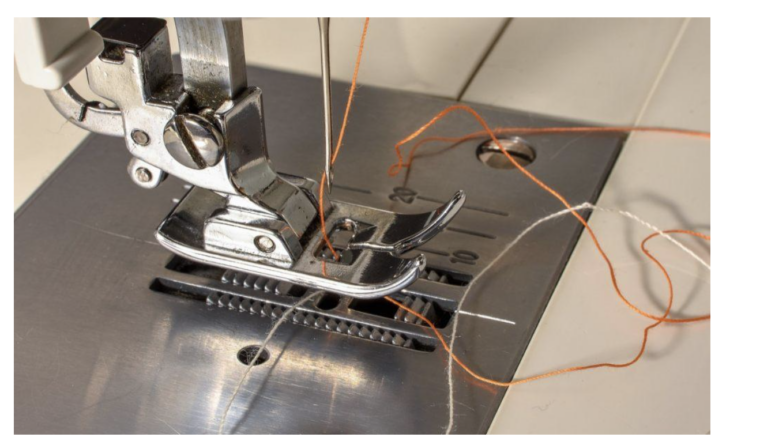Sewing SOS: How to Revive a Sluggish Needle in Action!
Has your sewing needle started moving slower than a snail stuck in molasses? Do you feel like yelling, “Why is my sewing machine needle not moving?!” every time you try to complete a project? Don’t panic! This common sewing machine issue can usually be quickly resolved with some easy troubleshooting.
A sluggish needle is super frustrating. Understanding what causes the slowdown and how to get your speed demon back will save many would-be stitchers from giving up in frustration! Ready to revive your laggy needle so you can enjoy smooth sewing again? Then, let’s get to the root of the issue!
Common Causes of a Sluggish Needle
Like any machine, sewing machines have many small parts that can cause significant issues when they get gummed up. Here are some of the most common culprits behind a dragging needle:
Built-Up Lint and Fabric Fuzz
Lint and fabric fuzz building up in the bobbin area is a leading cause of sudden needle lag. As the fluffy buildup increases, it causes added friction on the needle. The quick fix? Carefully clean out the area with a small brush and flashlight. Make sure no scraps are caught in the mechanism.
Bent or Damaged Needle
An obvious issue is an actual problem with the needle itself. If your needle gets bonked by pins or bent while sewing very thick material, it can lead to drag and slow movement. Check your needle for any warping and replace it if needed. Don’t let a damaged needle slow you down!
Low-Quality Thread
Cheapy thread that fuzzes easily is another culprit when your needle won’t budge. The fuzzy thread gums up the inner workings and bogs everything down. Splurge on some high-end thread and watch your needle sprint again!
Timing Issues
If none of the above fixes work, the timing of your sewing machine may be off. The needle bar and inner mechanisms can’t operate smoothly when the timing is misaligned. This leads to a very stubborn needle. It’s time for a tune-up!
DIY Troubleshooting Tips
Before making an appointment with the sewing doc, try these easy home remedies to get your needle moving well again:
Cleaning Out Lint Buildup
As mentioned above, a good detailed cleaning of lint and fuzzy buildup can work wonders! Make sure hard-to-reach spots are cleaned too. Go ahead and give the whole area a good scrub while you’re at it.
Replacing the Needle
Swap out your current needle for a fresh new one. To avoid any potential bending problems, make sure to use the proper needle size and type for your fabric project. Discard any warped needles so they don’t accidentally end up back in rotation.
Trying Higher Quality Thread
Ditch the cheap fuzzy thread for some premium brands that use long-strand fibers and resist excess fuzzing. A high-quality thread helps everything run smoothly.
Adjusting Tension Settings
Slowing down the needle mechanism may occur if the tension of the thread is too tight. Try loosening the tension setting slightly to remove drag and get it running fast again!
When to Call in a Professional
If you’ve tried all the DIY fixes for a slow needle to no avail, your machine may have deeper issues that require a tune-up by a sewing mechanic. Here are two instances when pros should get involved:
Timing Problems
If thorough cleaning doesn’t fix your stubborn needle, the timing of the inner mechanisms may be off. Adjusting the timing is complex and best left to sewing machine repair technicians. Well-calibrated timing is key for that lovely smooth sailing needle action!
Internal Damage or Wear
In some cases, internal parts like gears or drive belts may be damaged or excessively worn down, preventing smooth operation. Replacing damaged components requires partially disassembling the machine and is extremely challenging for beginners. Know your limits! Repairs requiring part replacements are best handled by pros.
Best Sewing Machine Buying Guide and Review
Looking for reliable sewing machine recommendations? Whether you want a basic mechanical model or a full-featured computerized machine, this buying guide covers the top-rated options to end your needle problems for good!
Top Mechanical Models
If you want a basic fuss-free model, look for mechanical machines like the Janome HD3000 Heavy Duty or the Singer 4423. No complex electronics to gum up the works! Many solid metal parts ensure smooth, precision performance that won’t quit on you.
Top Computerized Models
Are you looking for a few high-tech bells and whistles with reliability? Computerized models like the Brother CS6000i feature sturdy internal mechanisms plus handy time-saving performance features. Just avoid getting lured in by gimmicky extras that will drop in durability. Stick to solid core features for longevity.
Conclusion
Hopefully, these troubleshooting tips will help you swiftly resolve your frustrating needle slowdown situation! Always start with the easy fixes like cleaning buildup and replacing worn-out parts. When issues escalate, be sure to call in a professional for timing adjustments or internal repairs. Prevention is also vital—sticking with quality threads and fabrics will help avoid many common needle issues.
Have you struggled with sluggish needle problems before? What tactics finally got your machine back up to speed? Share your stories and insights to help other readers keep things flowing smoothly!

